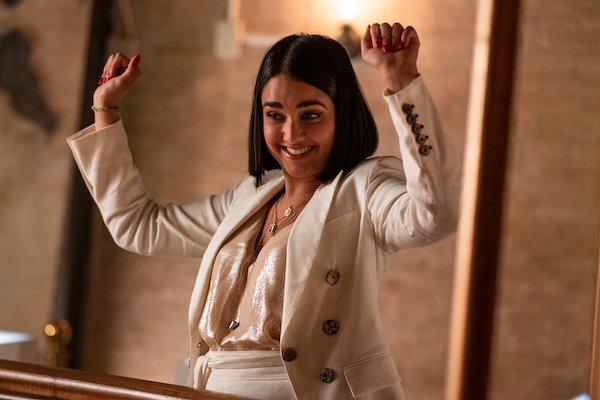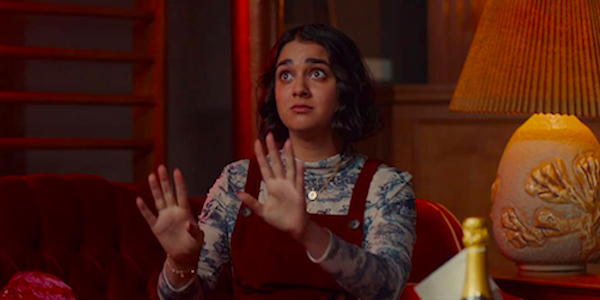With the holiday season comes an invitation to rediscover what makes us happiest – something that can often start and finish with a particularly comfortable, or colourful, outfit. This Christmas, we’re revisiting Natalie Krinsky’s The Broken Hearts Gallery with Rafaela Sales Ross, who finds a sense of self in repeated outfits, ready to take on the world.
‘We don't see things as they are, we see them as we are.’
-Anais Nin
Growing up, I was a gangly, overweight kid with glasses so big they were later recycled as a full set of car windows. I was also smart, caring and awfully kind, but I am yet to find a child who’s able to focus on the good. An outcast, I quickly lunged into anything that could favour my hiding, from corner seats to baggy, dark jumpers – even in the 40-degree heat of Rio de Janeiro.
Whilst my teenage colleagues discovered plumping bras, flashy tees and tight jeans, I switched the jumpers for men’s shirts. That was, until the day I stumbled upon the coolest, oddest pair of pantaloons when browsing for old DVDs in a secondhand shop. A mix of floral patches and big, colour-block sections, the trousers sat comfortably around my waistline, allowing me all the movement the restrictive yet very popular skinny jeans could never do. Paired with a black t-shirt depicting Brazilian cult horror king Zé do Caixão, an unwanted gift sent my way, the outfit became an instant uniform. No matter the occasion, there I was, bouncing along in my flashy combination of colour and darkness.
*
Natalie Krinsky’s The Broken Hearts Gallery revolves around Lucy, a young woman struggling to let go of an ever-growing collection of trinkets inherited from past relationships. Each object holds its own multitude of unfulfilled hopes and dreams, but instead of parting ways with the amalgamated pain, Lucy romanticises the dwelling experience of all her could-have-beens.
Like with memories and objects, Lucy collects outfits. Time and time again, the aspiring art curator can be seen wearing the same set of full ensembles. Not only the same shirt or dress but an entire outfit, from clothing to shoes, to the smallest of accessories. As with every other item she hoards, clothes offer portals into a familiar space: warm cocoons made out of cotton, jeans and corduroy.
As she slides yet again into a short burgundy dress and a white and blue floral turtleneck, Lucy believes herself capable of beating the inherent unpredictability of a new day. No longer are the sorrows of erstwhile able to affect her as she struts relentlessly into a new room, dripping with the kind of confidence only the perfect outfit can grant.
It is this seemingly never-ending coolness that allows Lucy to be so blatantly open, unafraid of the myriad of judgements lurking behind every dirty New York City corner. Here, gone is the mere idea of any ending other than a happy one. Yet, despite the almost over the top merriness, Lucy feels a deep sense of kinship with the broken-hearted, having had her own heart broken and battered more often than she would like to admit, a direct result of someone who dives headfirst into anything that feels remotely real.
The protagonist finds herself at that strange point in life when the unlimited aspirations of youth are diluted by the oftentimes dull reality of adulthood. When one needs to come to terms with the person they have become, while they were too preoccupied with becoming the person they envisioned. Dreams are no longer as enticing, as logistics weigh heavily on tired shoulders after yet another long shift. Nevertheless, Lucy swerves past inertia with the breath of a marathon runner, fuelled by the adrenaline of public humiliation and a dose of sheer naïveté – all with a silk handkerchief tied loosely around her neck.
*
In my mid 20s I left behind everything I knew. My country, my promising career, my family and friends. It didn’t take long, from the moment I stepped in dreich Scotland, for me to go into a full-blown quarter-life crisis. Lost in the uncommonness of my surroundings, every move drove me further into the sinking darkness of displacement. I missed the smell of freshly cut pineapple being sold from the back of a truck, the overwhelming sense of camaraderie that would fill a bus whenever a dozen people’s voices turned into one, desperately shouting to the driver that someone had missed their stop. I longed to hear the beautifully open vowels of my native language casually thrown into the air. Above all, I missed myself.
This drastic life change had confused what I believed was a very strong sense of identity. No longer could I be defined through the signature on a paycheque or a shared hobby that would occupy my sunny weekends. To stare in the mirror was to face a blank slate where once had stood a fully formed person.
The day the package arrived in the mail was a strangely nice one for the time of the year. Once opened, the perfect balance of bright shades of yellow and sobering black seemed to reflect the fickleness of the climate. The sunflower dungarees laid flat on top of my bed – silently challenging. Here, in the shape of quirky, trendy clothes, was a garment that felt everything but ordinary. Sporting an old, beaten Harold and Maude t-shirt, I put them on. Just as it happened once with old pantaloons, the outfit turned an illegible scribble into a Pulitzer prize winner. There I was again.
*
Painfully aware of the fleeting essence of memory, a shiny holy grail that can one day no longer rest on the precious mantle of routine, Lucy claws onto anything that will grant her the chance to linger on the quiet beauty of untarnished recollections. Her collecting habit is the precise reason the young woman allows herself to fall in love so deeply, to trust so blindly. If heartbreak comes, the warm cushion of the well-known will be waiting for her at home, and, eventually, the woes that weigh so heavily on her chest will become nothing more than another item on a shelf. She will leave her room once more, strutting down crowded streets in her favourite burgundy dress.
Rafaela Sales Ross (@rafiews) is a proud Brazilian currently living in Scotland. She has a Masters in Film and Visual Culture and is a researcher of the portrait of suicide on film. Rafa, as she likes to be called, loves Harold and Maude and writing about the exploration of death, existence and legacy on film.



